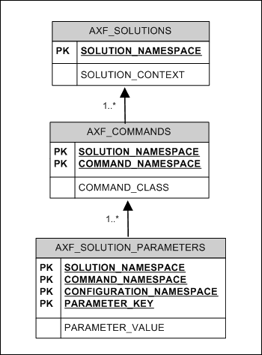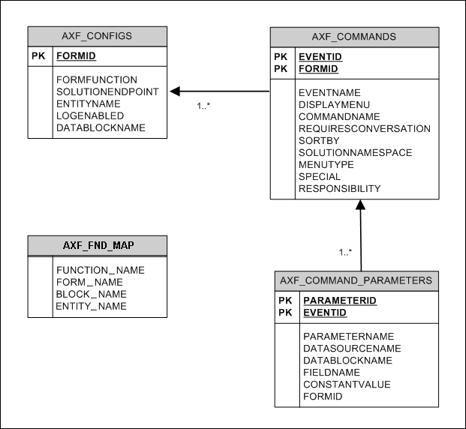| Oracle® Fusion Middleware Administrator's Guide for Oracle E-Business Suite Adapter for Oracle Enterprise Content Management 11g Release 1 (11.1.1) Part Number E15865-02 |
|
|
View PDF |
| Oracle® Fusion Middleware Administrator's Guide for Oracle E-Business Suite Adapter for Oracle Enterprise Content Management 11g Release 1 (11.1.1) Part Number E15865-02 |
|
|
View PDF |
The Managed Attachments Solution uses the following types of database tables, each configured for this solution:
Application Extension Framework (AXF) tables define the solution, its system parameters, and the GrantAccess command used. See "AXF Tables for Managed Attachments Solution".
E-Business Suite tables define how the Managed Attachments screen is activated through the Zoom menu on selected E-Business Suite forms. See "E-Business Suite Tables for Managed Attachments Solution".
Content Server tables define how Content Server documents are mapped to E-Business Suite business objects and how users are temporarily granted access to documents associated with a particular business object. See "Content Server Tables for Managed Attachments Solution".
These tables are automatically populated using database scripts, as explained in "Configuring E-Business Suite Components". However, this chapter describes how the tables are configured, in case you need to modify them.
Note:
If modifying AXF table values in a running system, either execute Clear DB Cache from the Driver page or restart the AXF application within the Application Server for the changes to take effect. For information about the Driver page, see "Verifying the AXF Installation with HelloWorld" in Oracle Fusion Middleware Installation Guide for Oracle Enterprise Content Management Suite.The diagram that follows displays the AXF configuration tables used for the E-Business Suite Managed Attachments solution and their relationships.

| AXF Table | Description |
|---|---|
| AXF_SOLUTIONS Table | Define AXF solutions and general parameters for infrastructure, services, and solutions. |
| AXF_COMMANDS Table | Define AXF commands within solutions. |
| AXF_SOLUTION_PARAMETERS Table | Define parameters for AXF commands. |
The AXF_SOLUTIONS table defines the solutions used by AXF. It links to the AXF_COMMANDS Table through the SOLUTION_NAMESPACE column.
This table defines AXF commands and their java classes for the solution. Each command's parameters are configured in the AXF_SOLUTION_PARAMETERS Table.
Table 6-3 Column Description for AXF_COMMANDS Table
| Column | Description |
|---|---|
|
SOLUTION_NAMESPACE |
The name of the solution, as defined in the AXF_SOLUTIONS Table. |
|
COMMAND_NAMESPACE |
Defines the unique name of the command within the solution. |
|
COMMAND_CLASS |
The fully qualified class name in which the command is defined. This class is loaded and the execute() method representing the command is executed. |
This table defines command parameters for the solution and AXF command.
Table 6-5 Column Description for AXF_SOLUTION_PARAMETERS Table
| Column | Description |
|---|---|
|
SOLUTION_NAMESPACE |
Identifies the solution namespace, as defined in the AXF_SOLUTIONS Table. |
|
COMMAND_NAMESPACE |
Specifies the command name, as defined in the AXF_COMMANDS Table. |
|
CONFIGURATION_NAMESPACE |
Used to implement the command. Specify the complete package name of the implementation class. This namespace path provides the physical Java class to be instantiated. The namespace also differentiates commands within the same solution namespace. |
|
PARAMETER_KEY |
Specifies the parameter key to be used in the AXF command. Parameters include:
|
|
PARAMETER_VALUE |
Specifies the value of the parameter key. |
This example defines the UCM_Managed_Attachments command for the EBS_Managed_Attachments solution. The first row specifies the RIDC connection string that executes the AF_GRANT_ACCESS UCM service. The second row specifies the Managed Attachments URL that invokes the Oracle UCM attachments framework search. The third row specifies the Oracle UCM administrative user who runs the AF_GRANT_ACCESS service; this username is dynamically retrieved.
Fields not shown: SOLUTION_NAMESPACE=EBS_Managed_Attachments
Table 6-6 Example AXF_SOLUTION_PARAMETERS Table for E-Business Suite Managed Attachments Solution
| COMMAND_NAMESPACE | CONFIGURATION_NAMESPACE | PARAMETER_KEY | PARAMETER_VALUE |
|---|---|---|---|
|
UCM_Managed_Attachments |
oracle.imaging.axf.commands.ucm.AfGrantAccessCommand |
RIDC_CONNECTION_STR |
idc://UCM host name or IP address: UCM server port |
|
UCM_Managed_Attachments |
oracle.imaging.axf.commands.ucm.AfGrantAccessCommand |
UCM_CONNECTION_STR |
http://UCM host name or IP address: WebServerPort/cs/idcplg/_p/min/af/trigger-EBSProfile?IdcService=GET_SEARCH_RESULTS_FORCELOGIN&ResultCount=20&ResultTemplate=EBS_LIST&SearchEngineName=DATABASE.METADATA.AFLIST |
|
UCM_Managed_Attachments |
oracle.imaging.axf.commands.ucm.AfGrantAccessCommand |
UCM_ADMIN_USER |
UCM admin user |
Each E-Business Suite form enabled for the AF integration requires an AXF E-Business Suite configuration that defines a Zoom Menu item with the label Managed Attachments and a set of parameters that include the E-Business Suite instance name, business object type, business object key(s), and user friendly description of the business object instance.
The diagram that follows displays the E-Business Suite configuration tables used for the E-Business Suite Managed Attachments solution and their relationships.

| E-Business Suite Table | Description |
|---|---|
| AXF_CONFIGS Table (E-Business Suite) | Enables the AXF solution on various E-Business Suite Forms. |
| AXF_COMMANDS Table (E-Business Suite) | Describes the actions to be taken based on user activity. |
| AXF_COMMAND_PARAMETERS Table (E-Business Suite) | Defines the information sent for the AfGrantAccess command. |
| AXF_FND_MAP Table (E-Business Suite) | Defines E-Business Suite form values to pass to the AfGrantAccessCommand when a user activates the Managed Attachments functionality from an E-Business Suite form. |
Use the AXF_CONFIGS table to enable the AXF solution on various E-Business Suite Forms. This table allows a fine level of granularity when selecting which forms are AXF-enabled.
When an action occurs, the customized code launches the specified solution and command configured for the event. When configured for the E-Business Suite adapter for Oracle UCM, this table invokes the AfGrantAccess command.
Table 6-7 Column Description for AXF_CONFIGS Table
| Column Name | Description | Data Type |
|---|---|---|
|
FORMID |
Specifies the primary key of the table. |
Number |
|
FORMFUNCTION |
Distinguishes each E-Business Suite Form based on the form's functionality. |
Varchar2 (100 byte) |
|
SOLUTIONENDPOINT |
Specifies a URL to AXF. |
Varchar2 (1000 byte) |
|
ENTITYNAME |
Used by the attachment functionality as a unique name, which links attachments to the correct forms. |
Varchar2 (100 byte) |
|
LOGENABLED |
Enables or disables the log for the specified form. See "Enabling E-Business Suite Logging". Specify one of the following:
|
Varchar2 (10 byte) |
|
DATABLOCKNAME |
Specify the data block on the form to be enabled. Note that you can also specify A Form may be reused by E-Business Suite (for example, Invoice Entry and Invoice Query); the FORMFUNCTION and DATABLOCKNAME together uniquely identify each form. |
Varchar2 (100 byte) |
This example defines the AfGrantAccess command in the AXF_CONFIGS table for the Invoice Entry form.
To enable logging for a particular Form function, set the LOGENABLED field to either 1, YES or TRUE and the file is created in the UTL_FILE_DIR folder. Consult with your DBA to verify that the UTL_FILE_DIR folder is available and accessible. Log files are named Username_MASTER_LOG.txt, and continue to grow as items are appended.
Use the AXF_COMMANDS table to describe the actions to be taken based on user activity. This table works with the AXF_CONFIGS Table (E-Business Suite).
Table 6-9 Column Description for AXF_COMMANDS Table
| Column Name | Description | Data Type | Nullable |
|---|---|---|---|
|
FORMID |
Links to the AXF_CONFIGS Table (E-Business Suite). |
Number |
No |
|
EVENTID |
Primary key of the table. |
Number |
Yes |
|
EVENTNAME |
Name of the Event command to be invoked (ZOOM for this adapter). |
Varchar2 (100 byte) |
Yes |
|
DISPLAYMENU |
Displays text of the menu for the command. |
Varchar2 (100 byte) |
Yes |
|
COMMANDNAMESPACE |
Request command to be passed to the back-end when the menu is selected. |
Varchar2 (100 byte) |
Yes |
|
REQUIRESCONVERSATION |
Indicates if the command requires a valid conversation or not. For this adapter, this value must be NO. |
Varchar2 (10 byte) |
Yes |
|
SORTBY |
Order in which the menu is displayed. |
Number |
Yes |
|
SOLUTIONNAMESPACE |
Name of the solution. |
Varchar2 (100 byte) |
Yes |
|
MENUTYPE |
Specify the menu type to display to users in E-Business Suite. ZOOM displays a Zoom menu in the toolbar. |
Varchar2 (25 byte) |
Yes |
|
SPECIAL |
Create new menu entries by entering a unique number for the Special type menu. (Not applicable for this adapter.) |
Varchar2 (10 byte) |
Yes |
|
RESPONSIBILITY |
Use this column to filter the menu options based on user responsibility. Enter a value to display the menu only to end users with responsibilities associated with that value. (Not applicable for this adapter.) |
Varchar2 (100 byte) |
Yes |
Use the AXF_COMMAND_PARAMETERS table to define the information sent for each defined command. Each command may require or omit a different set of parameters.
Table 6-11 Column Description for AXF_COMMAND_PARAMETERS Table
| Column | Description |
|---|---|
|
PARAMETERID |
Defines a unique ID for the parameter. |
|
EVENTID |
Defines a unique ID for the event. Comes from the AXF_COMMANDS Table (E-Business Suite). |
|
PARAMETERNAME |
The name of the parameter to be passed. For this solution, this value must be set to:
|
|
DATASOURCENAME |
Data Source for the parameter value. You can specify Data or Constant. |
|
DATABLOCKNAME |
Data Block of the Form from which the value is fetched |
|
FIELDNAME |
Field Name in the form from which the value is fetched. |
|
CONSTANTVALUE |
Must be set to a value that uniquely identifies the E-Business Suite instance. |
This table relates to an E-Business Suite form's values passed to the AfGrantAccessCommand when a user activates the Managed Attachments functionality from an E-Business Suite form. The adapter looks up values for the E-Business Suite form in this table and passes them to the AfGrantAccessCommand for executing the Oracle UCM AF_GRANT_ACCESS service and Oracle UCM attachments framework search.
Table 6-13 Column Description for AXF_FND_MAP Table
| Column | Description |
|---|---|
|
FUNCTION_NAME |
Defines the E-Business Suite Form based on its functionality. |
|
FORM_NAME |
Defines the name of the E-Business Suite form to be enabled. |
|
BLOCK_NAME |
Defines the data block on the form to be enabled. |
|
ENTITY_NAME |
Used by the attachment functionality as a unique name, which links attachments to the correct forms. |
The adapter uses the following additional database tables:
These tables are automatically populated. AFGrants is initially populated when the user accesses Oracle UCM from E-Business Suite and the AF_GRANT_ACCESS service is run. AFObjects is populated when the user checks in a document to Oracle UCM from the Managed Attachments screen.
This table maps Content Server documents to AF business objects, in an N-to-N relationship, which allows multiple content items to be associated with a single business object and multiple business objects to contain the same content item.
Table 6-15 Column Description for AFObjects Table
| Column | Description |
|---|---|
|
dAFApplication |
Specifies the business application's instance name. |
|
dAFBusinessObjectType |
Specifies the business application's object type |
|
dAFBusinessObject |
Specifies the business object's ID in the business application instance. |
|
dDocName |
Specifies a content item's ID associated with the business object. |
This table stores the grants given to users, allowing them to temporarily access documents associated with a particular business object.
Table 6-16 Column Description for AFGrants Table
| Columns | Description |
|---|---|
|
dUserName |
Specifies the name of the user. |
|
dAfApplication |
Specifies the business application's instance name. |
|
dAfBusinessObject |
Specifies the business application's object |
|
dAfBusinessObjectType |
Specifies the business application's object type |
|
dPrivilege |
Specifies the privilege to grant to the user: R (read), W (write), D (delete), or A (admin). This parameter is optional. If not specified, the access level specified for the AppAdapterGrantPrivilege configuration variable is used, as described in "Setting the Configuration Variables". |
|
dExpirationDate |
The date and time at which to expire this grant. |
|
dMaxExpiration |
The time at which the maximum access period (in hours) expires. |